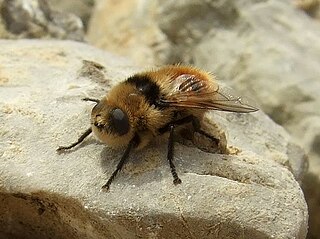
A crane fly is any member of the dipteran superfamily Tipuloidea, which contains the living families Cylindrotomidae, Limoniidae, Pediciidae and Tipulidae, as well as several extinct families. "Winter crane flies", members of the family Trichoceridae, are sufficiently different from the typical crane flies of Tipuloidea to be excluded from the superfamily Tipuloidea, and are placed as their sister group within Tipulomorpha.

The Tachinidae are a large and variable family of true flies within the insect order Diptera, with more than 8,200 known species and many more to be discovered. Over 1,300 species have been described in North America alone. Insects in this family commonly are called tachinid flies or simply tachinids. As far as is known, they all are protelean parasitoids, or occasionally parasites, of arthropods, usually other insects. The family is known from many habitats in all zoogeographical regions and is especially diverse in South America.

Botflies, also known as warble flies, heel flies, and gadflies, are a family of flies known as the Oestridae. Their larvae are internal parasites of mammals, some species growing in the host's flesh and others within the gut. Dermatobia hominis is the only species of botfly known to parasitize humans routinely, though other species of flies cause myiasis in humans.

Dolichopodidae, the long-legged flies, are a large, cosmopolitan family of true flies with more than 8,000 described species in about 250 genera. The genus Dolichopus is the most speciose, with some 600 species.

Mesembrinella caenozoica is an extinct species of blow fly in the family Mesembrinellidae. The species is solely known from the Middle Miocene Dominican amber deposits on the island of Hispaniola.

Mesembrinellidae is a family of Neotropical flies in the order Diptera, and formerly included in the Calliphoridae. There are 36 described species.

Mesembrinella is a genus of Neotropical flies in the family Mesembrinellidae, and formerly placed in the Calliphoridae.

Mesembrinellinae is a subfamily of Neotropical flies in the order Diptera, and formerly included in the Calliphoridae. There are 33 described living species.
Mesembrinella spicata is a species of fly in the family Mesembrinellidae.
Laneella is a genus of flies in the family Mesembrinellidae.
Laneellinae is a subfamily of Neotropical flies in the family Mesembrinellidae, and formerly placed in the Calliphoridae.
Mesembrinella xanthorrhina is a species of fly in the family Mesembrinellidae. It is found from southern Mexico to Peru and Venezuela.

Mesembrinella socors is a species of fly in the family Mesembrinellidae. It is found in Mexico.

Mesembrinella randa is a species of fly in the family Mesembrinellidae. It is found in Guyana, French Guiana, Surinam, and Brazil.
Mesembrinella cyaneicincta is a species of fly in the family Mesembrinellidae.
Mesembrinella aeneiventris is a species of fly in the family Mesembrinellidae.
Souzalopesiella is a genus of flies in the family Mesembrinellidae.
Laneella fuscosquamata is a species of fly in the family Mesembrinellidae.
Laneella nigripes is a species of fly in the family Mesembrinellidae. It is found in Brazil.







